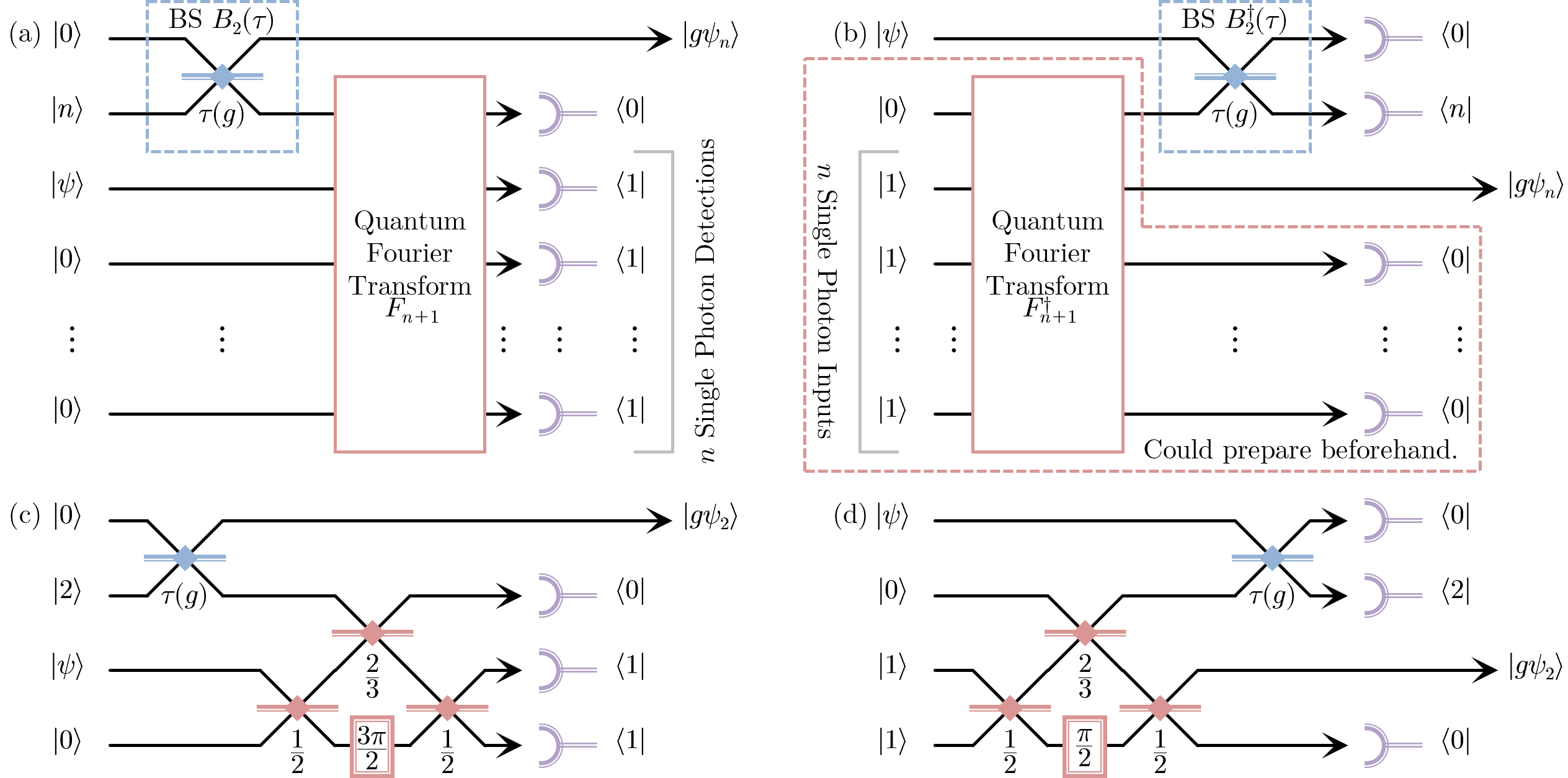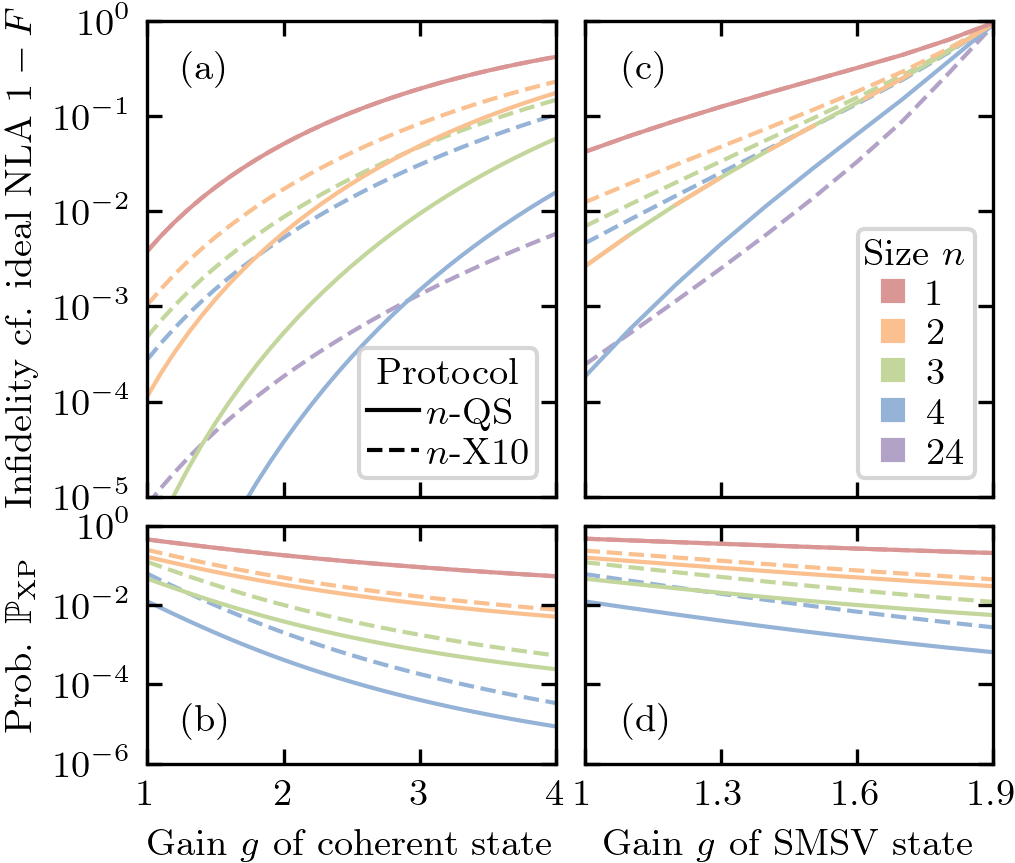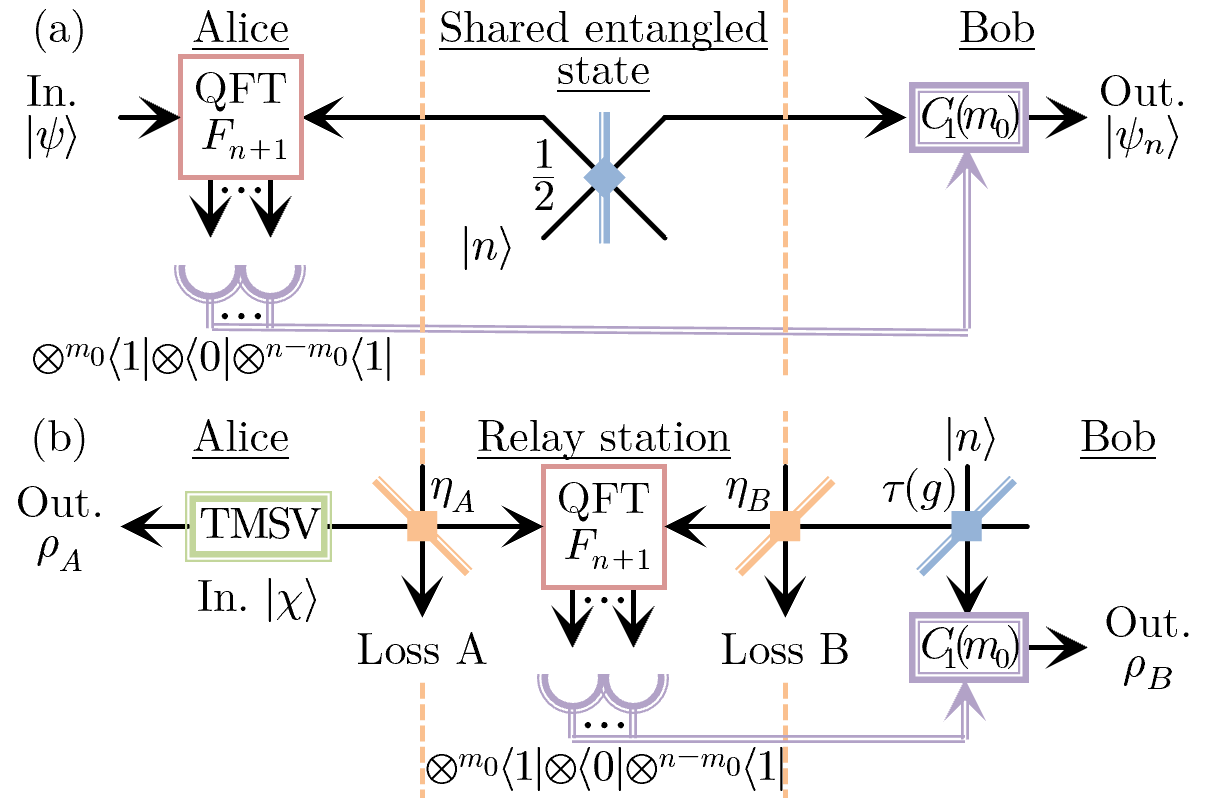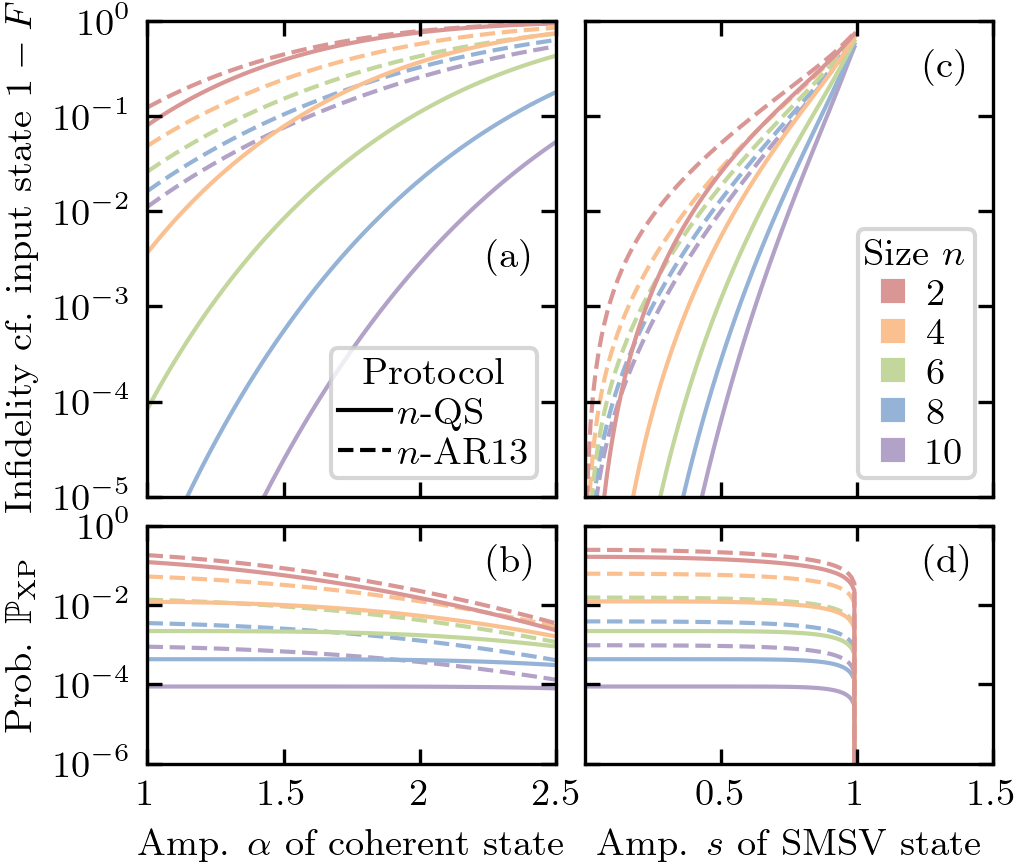Ideal Quantum Tele-amplification up to a Selected Energy Cut-off using Linear Optics
Abstract
We introduce a linear optical technique that can implement ideal quantum tele-amplification up to the Fock state, where can be any positive integer. Here tele-amplification consists of both quantum teleportation and noiseless linear amplification (NLA). This simple protocol consists of a beam-splitter and an -splitter, with ancillary photons and detection of photons. For a given target fidelity, our technique improves success probability and physical resource costs by orders of magnitude over current alternative teleportation and NLA schemes. We show how this protocol can also be used as a loss-tolerant quantum relay for entanglement distribution and distillation.
The ability to amplify an arbitrary state in a linear, or phase insensitive, manner is useful for a wide variety of quantum protocols. Unfortunately, the uncertainty principle means deterministic linear amplification will always introduce noise, which diminishes the output state’s quantum characteristics [1, 2]. However, noiseless linear amplification (NLA) is possible for non-deterministic amplifiers, which work with some success probability [3, 4, 5]. Applications of NLA include quantum secure communication [6, 7, 8, 9, 10, 11], quantum repeaters [12, 13, 14], entanglement distillation [15, 16], quantum sensing [17, 18, 19], and quantum error correction [20, 21].
Quantum tele-amplification protocols implement quantum teleportation [22] and NLA simultaneously. In this regard, Pegg et al. proposed a non-deterministic teleporter for low-energy states called the one-photon quantum scissor (-QS), named for its ability to cut or truncate an arbitrary state up to its one-photon Fock state [23]. Ralph and Lund later realised adjusting a beam-splitter in the -QS modified the output state’s amplitudes [3]. Hence, for low-energy states, the -QS can also perform an ideal NLA operation up to the one-photon Fock state with gain; this was subsequently experimentally verified [4, 5]. To overcome the low-energy limitation, it was proposed to split up the input state, before applying multiple -QS in parallel [3, 4]. However, for a finite number of -QS, this protocol introduces extra undesirable factors to the Fock states, distorting the output state away from the ideal. Other NLA proposals are similarly non-ideal [24, 25, 26].
Rather than multiple -QS in parallel, here we propose to generalise the -QS to the -photons quantum scissor (-QS), for any . Previous generalisations of the QS were only for specific sizes [27], and our fully generalised -QS protocol contains these previous results 111See Supplemental Material at [URL will be inserted by publisher] for the details about the technical proofs for the -QS operations, probability of success with improvements, fidelity of output state, comparisons with other NLA protocols, loss-tolerant entanglement distillation analysis, and experimental imperfections analysis, which includes Ref. [54, 55, 56, 57, 58, 3, 27, 51, 59, 38, 60, 61, 62, 63, 64, 65, 4, 37]. Our -QS protocol is a fully scalable linear optical scheme, which can perform tele-amplification on an arbitrary state perfectly up to the Fock state. Other tele-amplification proposals are restricted to specific types of input states [29]. The -QS case is of particular experimental interest, as it should be immediately accessible with current technology.
In this Letter, we first describe our -QS protocol, including its operational mechanism and probability of success. We show that as an NLA it can produce amplified states with fidelities that are unreachable by previous linear-optical NLA protocols. Next, we explain how the -QS is also useful as a high-fidelity continuous-variable teleporter, with orders of magnitude advantages over current alternatives. We then show that the -QS can be used as a loss-tolerant relay for entanglement distillation. Finally, we discuss how our scheme is tolerant to standard resource and detector imperfections, and hence remains advantageous under practical conditions.

Noiseless linear amplifier.—The -QS operation on an arbitrary bosonic state truncates the Fock components after and performs NLA as follows
| (1) |
This is implemented via Fig. 1 using a beam-splitter (BS) and a fixed coherent -splitter called the Quantum Fourier Transform (QFT), with extra resource photons and photon detections. The amount of amplification or de-amplification gain can be freely chosen by setting the BS transmissivity to . The -QS operation only occurs if the correct outcomes are measured. Two different architectures are shown in Fig. 1, with (a) requiring bunched photons (-QSBP or BP), while (b) requiring single photons (-QSSP or SP); we will differentiate these devices by their state resources. Due to recent experimental advances, such as in boson sampling, -QSSP may be easier to implement; for example, Ref. [30] experimentally implements the QFT up to fourth order with single-photon inputs.
The action of the BS is , which describes how the photons are scattered for a given transmissivity . Similarly, the action of an mode linear optical network is captured by an unitary scattering matrix . The QFT optical device has the scattering matrix . This definition justifies the interpretation of the QFT as a coherent -splitter, as it scatters photons equally amongst its output ports with fixed phases. An arbitrary unitary can always be decomposed into a network of at most beam-splitters and phase shifts [31, 32]; however, only around half of the QFT network is needed since only the first two ports are used. As an example, we use Ref. [32] to decompose -QS into a four BS network, as shown in Fig. 1 for either (c) BP , or (d) SP resources. The -QS is the smallest network whose useful tele-amplification properties were previously not known.
Here we will highlight the key elements which prove Fig. 1 implements the -QS transformation in Eq. (1) . Firstly, one can show that , which already has the gain coefficients, though with unwanted factors. The red dashed box in (b) produces the two-mode output . In other words, the state distorts the Fock states in an inverse manner to . Hence, by combining one mode from each of these states, the overall action of the -QSSP is
| (2) |
The -QSBP is described by the same operator, since it is the conjugate transpose of this expression. The -QS therefore applies ideal up to the Fock state
| (3) |
The Supplemental Material contains the full proof [28].

The -QS has a success probability of , which can be improved depending on whether we are considering the BP or SP configuration. For -QSBP, it is not required that the vacuum state be detected at the first output port of , since the QFT is highly symmetric. If was instead detected in the output port , , the output state will be with an extra phase shift that can be corrected by [28]. Utilizing all heralding events enhances the success probability by . For -QSSP, the resource state from the red dashed box in Fig. 1(b) could be prepared and stored beforehand; assuming is deterministically available increases the success probability to at least [28]. Note that for , for , and for [28]. Since there is no difference between the output states of these configurations, we will use depending on the size under consideration.
We will now contrast our protocol with Xiang, et al. 2010 (X10) linear optical NLA protocol [4]. An sized X10 network has copies of -QS in parallel between two -splitters, hence requires approximately the same amount of physical resources as an -QS. One advantage of the simplified -QS structure is that setting a particular gain requires changing just one BS, while -X10 requires changing BS concurrently. The output state from -X10 has both the cut-off and distorted coefficients
| (4) |
hence the NLA is not ideal in general [3]. The fidelity can quantify how far away these output states are from the ideal NLA output state [28]. It is clear an -QS can amplify any arbitrary state with a upper energy limit with perfect fidelity. This feat cannot be replicated by any finite sized -X10, or by any previous linear-optical NLA protocol [24, 25].
In Fig. 2 we consider amplifying a coherent state and a single-mode squeezed vacuum (SMSV) state. Our -QS has superior fidelity scaling, and hence for a required target fidelity needs much less resources with better success probability than the -X10. For example, Fig. 2(a) and (b) shows amplifying the coherent state by with 99.9% fidelity requires only an -QS with success probability, as opposed to a much larger -X10 with success probability. Fig. 2(c) and (d) emphasize the flexibility of our -QS protocol, in that we can choose the best size for a given input; since SMSV states contain only even photon numbers, it is best to use even sized -QS (odd sizes will give the same fidelity as one size down). These graphs also show the -QS has fidelity advantages even with amplifying SMSV states near maximum squeezing given by (here ).

Quantum teleporter.—Quantum teleportation is a key primitive in quantum protocols [33, 34, 35], since it allows for the transfer and manipulation of quantum information through a shared entangled state; this is possible in both discrete variable [22] and continuous variable (CV) [36] regimes. Andersen and Ralph in 2013 (AR13) proposed a CV teleportation scheme [37], which could in principle reach high fidelities with lower energy requirements than standard CV teleportation [36]. However, in a similar manner as X10, a finite sized AR13 protocol distorts the output state. We will demonstrate our -QS with , as in Fig. 3(a), is a better protocol for high-fidelity teleportation. We restrict ourselves to linear-optical systems, hence both -AR13 and -QS are non-deterministic, and require a comparable amount of physical resources.

We consider teleporting coherent and SMSV states with various amplitudes in Fig. 4; we chose higher valued energy states to show the advantage of our scheme for larger . It is clear our -QS scales with many orders of magnitude better fidelity in comparison to -AR13, while the probability of success scales comparatively. For example, teleporting an SMSV using a -QS results in superior fidelity and success probability, while requiring less resources compared to a -AR13.
The AR13 paper illustrated the effectiveness of their protocol by analysing the teleportation of a coherent state superposition with . The authors note that to achieve just over 99% fidelity, the standard teleportation approach requires 500 average photons (30 dB of squeezing) [36], while -AR13 requires an photon entangled state [37]. To reach the same fidelity, our -QS protocol requires just photons.

Loss-tolerant quantum relay.—Here we consider distilling entanglement through a loss channel with total transmissivity. The -QS can function as a quantum relay by distributing the QFT measurement component over the channel, as shown in Fig. 3(b), such that . The distributed -QS has previously been shown to be uniquely loss tolerant, in that it can overcome the repeaterless PLOB bound without quantum memories [38]; the only other known scheme that can also do this feat is the twin-field QKD protocol and its variants [39, 40, 41, 42]. We confirm that the complete set of distributed -QS are also loss tolerant with improved usage rates. In other words, instead of having the entire NLA at Bob’s side (), by placing the QFT measurement half way (), we improve success probability scaling from to [28]. Note here we consider distilling a two-mode squeezed vacuum (TMSV) or EPR state with squeezing.
The logarithmic negativity (LN) is an entanglement monotone [43, 44], and an upper bound for distillable entanglement [45]. The LN is shown by the solid lines in Fig. 5(a), which increases with larger sizes. Maximum LN occurs with gain approximately (here ), which corresponds to an output state that is uniformly distributed in the Fock basis [28]. The dashed lines in these graphs only considers the second moment covariance correlations, which are more relevant for Gaussian and CV protocols [46].
The entanglement of formation (EOF) is an entanglement metric [47], whose properties for multi-mode Gaussian states are known [48, 49, 50, 51, 52]. Fig 5(b) is the Gaussian EOF, which closely resembles the covariance-based LN, as expected. The gray horizontal lines are pure loss channels with no QS, where the dashed line has the same initial squeezing , and the dotted line is the deterministic bound with infinite squeezing ; it’s clear this bound can be beaten by small sized -QS. Increasing loss doesn’t significantly change the maximum amount of distillable entanglement, which is another experimental appealing feature of this loss tolerant protocol [28].
Experimental imperfections.—Finally, we examined the effect of noisy, inefficient photon detectors and sources. We showed that our -QSBP protocol is tolerant to experimental imperfections, in the same sense as the already experimentally verified -QS [4]. In other words, an imperfect -QSBP as an amplifier, teleporter or relay results in relative improvements with increased , in a similar fashion as the ideal graphs in this Letter. Unfortunately, the -QSSP is not tolerant to experimental imperfections. This is because of how the entanglement resource is prepared, and a different preparation scheme could help to improve an imperfect -QSSP. See the Supplemental Material for more details [28].
Conclusion.—We introduced the generalised quantum scissors, which can perform perfect fidelity tele-amplification up to the Fock state. We proved that this operation can be implemented using two simple scalable linear-optical networks, with either single or bunched ancillary photons. As a consequence, our -QS protocol is shown to have substantial advantages over existing NLA and teleportation schemes, in terms of fidelity scaling, success probability and physical resources. Finally, we showed that a distributed -QS quantum relay is loss-tolerant with fast rates, hence is useful as building blocks for quantum repeater networks.
Acknowledgements.
APL acknowledges support from BMBF (QPIC) and the Einstein Research Unit on Quantum Devices. This research was supported by the Australian Research Council (ARC) under the Centre of Excellence for Quantum Computation and Communication Technology (Project No. CE170100012).Note added.—The authors recently became aware of a new related work which investigated noiseless quantum tele-amplifiers from a different angle [53], based on the continuous-variable teleportation protocol [36].
References
- Heffner [1962] H. Heffner, Proceedings of the IRE 50, 1604 (1962).
- Caves [1981] C. M. Caves, Physical Review D 23, 1693 (1981).
- Ralph and Lund [2009] T. C. Ralph and A. P. Lund, in AIP Conference Proceedings, Vol. 1110 (American Institute of Physics, 2009) pp. 155–160.
- Xiang et al. [2010] G.-Y. Xiang, T. C. Ralph, A. P. Lund, N. Walk, and G. J. Pryde, Nature Photonics 4, 316 (2010).
- Ferreyrol et al. [2010] F. Ferreyrol, M. Barbieri, R. Blandino, S. Fossier, R. Tualle-Brouri, and P. Grangier, Physical review letters 104, 123603 (2010).
- Gisin et al. [2010] N. Gisin, S. Pironio, and N. Sangouard, Physical review letters 105, 070501 (2010).
- Blandino et al. [2012] R. Blandino, A. Leverrier, M. Barbieri, J. Etesse, P. Grangier, and R. Tualle-Brouri, Physical Review A 86, 012327 (2012).
- Xu et al. [2013] B. Xu, C. Tang, H. Chen, W. Zhang, and F. Zhu, Physical Review A 87, 062311 (2013).
- Ghalaii et al. [2020] M. Ghalaii, C. Ottaviani, R. Kumar, S. Pirandola, and M. Razavi, IEEE Journal of Selected Topics in Quantum Electronics 26, 1 (2020).
- Zhou et al. [2020] L. Zhou, Y.-B. Sheng, and G.-L. Long, Science Bulletin 65, 12 (2020).
- Li et al. [2021] Y. Li, Y. Guo, X. Ruan, and W. Zhao, International Journal of Theoretical Physics 60, 1949 (2021).
- Dias and Ralph [2017] J. Dias and T. C. Ralph, Physical Review A 95, 022312 (2017).
- Dias et al. [2020] J. Dias, M. S. Winnel, N. Hosseinidehaj, and T. C. Ralph, Physical Review A 102, 052425 (2020).
- Seshadreesan et al. [2020] K. P. Seshadreesan, H. Krovi, and S. Guha, Physical Review Research 2, 013310 (2020).
- Zhang et al. [2012] S. L. Zhang, S. Yang, X. B. Zou, B. S. Shi, and G. C. Guo, Physical Review A 86, 034302 (2012).
- Seshadreesan et al. [2019] K. P. Seshadreesan, H. Krovi, and S. Guha, Physical Review A 100, 022315 (2019).
- Usuga et al. [2010] M. A. Usuga, C. R. Müller, C. Wittmann, P. Marek, R. Filip, C. Marquardt, G. Leuchs, and U. L. Andersen, Nature Physics 6, 767 (2010).
- Zhao et al. [2017] J. Zhao, J. Dias, J. Y. Haw, T. Symul, M. Bradshaw, R. Blandino, T. Ralph, S. M. Assad, and P. K. Lam, Optica 4, 1421 (2017).
- Xia et al. [2019] Y. Xia, Q. Zhuang, W. Clark, and Z. Zhang, Physical Review A 99, 012328 (2019).
- Ralph [2011] T. C. Ralph, Physical Review A 84, 022339 (2011).
- Dias and Ralph [2018] J. Dias and T. C. Ralph, Physical Review A 97, 032335 (2018).
- Bennett et al. [1993] C. H. Bennett, G. Brassard, C. Crépeau, R. Jozsa, A. Peres, and W. K. Wootters, Physical review letters 70, 1895 (1993).
- Pegg et al. [1998] D. T. Pegg, L. S. Phillips, and S. M. Barnett, Physical review letters 81, 1604 (1998).
- Fiurášek [2009] J. Fiurášek, Physical Review A 80, 053822 (2009).
- Zavatta et al. [2011] A. Zavatta, J. Fiurášek, and M. Bellini, Nature photonics 5, 52 (2011).
- Jeffers [2010] J. Jeffers, Physical Review A 82, 063828 (2010).
- Winnel et al. [2020] M. S. Winnel, N. Hosseinidehaj, and T. C. Ralph, Physical Review A 102, 063715 (2020).
- Note [1] See Supplemental Material at [URL will be inserted by publisher] for the details about the technical proofs for the -QS operations, probability of success with improvements, fidelity of output state, comparisons with other NLA protocols, loss-tolerant entanglement distillation analysis, and experimental imperfections analysis, which includes Ref. [54, 55, 56, 57, 58, 3, 27, 51, 59, 38, 60, 61, 62, 63, 64, 65, 4, 37].
- Neergaard-Nielsen et al. [2013] J. S. Neergaard-Nielsen, Y. Eto, C.-W. Lee, H. Jeong, and M. Sasaki, Nature Photonics 7, 439 (2013).
- Su et al. [2017] Z.-E. Su, Y. Li, P. P. Rohde, H.-L. Huang, X.-L. Wang, L. Li, N.-L. Liu, J. P. Dowling, C.-Y. Lu, and J.-W. Pan, Physical review letters 119, 080502 (2017).
- Reck et al. [1994] M. Reck, A. Zeilinger, H. J. Bernstein, and P. Bertani, Physical Review Letters 73, 58 (1994).
- Clements et al. [2016] W. R. Clements, P. C. Humphreys, B. J. Metcalf, W. S. Kolthammer, and I. A. Walmsley, Optica 3, 1460 (2016).
- Kimble [2008] H. J. Kimble, Nature 453, 1023 (2008).
- Gottesman and Chuang [1999] D. Gottesman and I. L. Chuang, Nature 402, 390 (1999).
- Chen et al. [2021] M.-C. Chen, Y. Li, R.-Z. Liu, D. Wu, Z.-E. Su, X.-L. Wang, L. Li, N.-L. Liu, C.-Y. Lu, and J.-W. Pan, Physical Review Letters 127, 030402 (2021).
- Braunstein and Kimble [1998] S. L. Braunstein and H. J. Kimble, Physical Review Letters 80, 869 (1998).
- Andersen and Ralph [2013] U. L. Andersen and T. C. Ralph, Physical review letters 111, 050504 (2013).
- Winnel et al. [2021] M. S. Winnel, J. J. Guanzon, N. Hosseinidehaj, and T. C. Ralph, arXiv preprint arXiv:2105.03586 (2021).
- Lucamarini et al. [2018] M. Lucamarini, Z. L. Yuan, J. F. Dynes, and A. J. Shields, Nature 557, 400 (2018).
- Liu et al. [2019] Y. Liu, Z.-W. Yu, W. Zhang, J.-Y. Guan, J.-P. Chen, C. Zhang, X.-L. Hu, H. Li, C. Jiang, J. Lin, T.-Y. Chen, L. You, Z. Wang, X.-B. Wang, Q. Zhang, and J.-W. Pan, Physical Review Letters 123, 100505 (2019).
- Curty et al. [2019] M. Curty, K. Azuma, and H.-K. Lo, npj Quantum Information 5, 1 (2019).
- Chen et al. [2020] J.-P. Chen, C. Zhang, Y. Liu, C. Jiang, W. Zhang, X.-L. Hu, J.-Y. Guan, Z.-W. Yu, H. Xu, J. Lin, M.-J. Li, H. Chen, H. Li, L. You, Z. Wang, X.-B. Wang, Q. Zhang, and J.-W. Pan, Physical review letters 124, 070501 (2020).
- Audenaert et al. [2003] K. Audenaert, M. B. Plenio, and J. Eisert, Physical review letters 90, 027901 (2003).
- Plenio [2005] M. B. Plenio, Physical review letters 95, 090503 (2005).
- Vidal and Werner [2002] G. Vidal and R. F. Werner, Physical Review A 65, 032314 (2002).
- Adesso et al. [2004] G. Adesso, A. Serafini, and F. Illuminati, Physical Review A 70, 022318 (2004).
- Bennett et al. [1996] C. H. Bennett, D. P. DiVincenzo, J. A. Smolin, and W. K. Wootters, Physical Review A 54, 3824 (1996).
- Wolf et al. [2004] M. M. Wolf, G. Giedke, O. Krüger, R. F. Werner, and J. I. Cirac, Physical Review A 69, 052320 (2004).
- Marian and Marian [2008] P. Marian and T. A. Marian, Physical review letters 101, 220403 (2008).
- Tserkis and Ralph [2017] S. Tserkis and T. C. Ralph, Physical Review A 96, 062338 (2017).
- Tserkis et al. [2019] S. Tserkis, S. Onoe, and T. C. Ralph, Physical Review A 99, 052337 (2019).
- Onoe et al. [2020] S. Onoe, S. Tserkis, A. P. Lund, and T. C. Ralph, Physical Review A 102, 042408 (2020).
- Fiurášek [2021] J. Fiurášek, arXiv preprint arXiv:2110.06040 (2021).
- Scheel [2004] S. Scheel, arXiv preprint quant-ph/0406127 (2004).
- Gard et al. [2015] B. T. Gard, K. R. Motes, J. P. Olson, P. P. Rohde, and J. P. Dowling, in From atomic to mesoscale: The role of quantum coherence in systems of various complexities (World Scientific, 2015) pp. 167–192.
- Lund et al. [2017] A. P. Lund, M. J. Bremner, and T. C. Ralph, npj Quantum Information 3, 1 (2017).
- Brualdi et al. [1991] R. A. Brualdi, H. J. Ryser, et al., Combinatorial matrix theory, Vol. 39 (Springer, 1991).
- Percus [2012] J. K. Percus, Combinatorial methods, Vol. 4 (Springer Science & Business Media, 2012).
- García-Patrón et al. [2009] R. García-Patrón, S. Pirandola, S. Lloyd, and J. H. Shapiro, Physical review letters 102, 210501 (2009).
- Reddy et al. [2019] D. V. Reddy, R. R. Nerem, A. E. Lita, S. W. Nam, R. P. Mirin, and V. B. Verma, in CLEO: QELS_Fundamental Science (Optical Society of America, 2019) pp. FF1A–3.
- Lita et al. [2008] A. E. Lita, A. J. Miller, and S. W. Nam, Optics express 16, 3032 (2008).
- Marsili et al. [2013] F. Marsili, V. B. Verma, J. A. Stern, S. Harrington, A. E. Lita, T. Gerrits, I. Vayshenker, B. Baek, M. D. Shaw, R. P. Mirin, et al., Nature Photonics 7, 210 (2013).
- Miller et al. [2003] A. J. Miller, S. W. Nam, J. M. Martinis, and A. V. Sergienko, Applied Physics Letters 83, 791 (2003).
- Slussarenko and Pryde [2019] S. Slussarenko and G. J. Pryde, Applied Physics Reviews 6, 041303 (2019).
- Su et al. [2019] D. Su, C. R. Myers, and K. K. Sabapathy, Physical Review A 100, 052301 (2019).